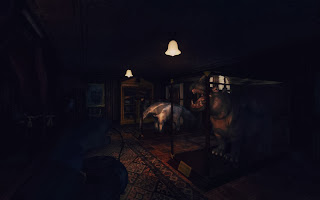 Review by V8Ninja.
Review by V8Ninja.
Amnesia: A Machine For Pigs was not developed by Frictional Games. Rather, the game was developed by The Chinese Room. The Chinese Room’s resume only features one video game, which was Dear Esther.
While I cannot judge any of the claims, many individuals criticised Dear Esther for taking away all meaningful player interaction and replacing it with story and meticulously crafted environments, with many coming to the conclusion that Dear Esther was primarily a set of pretty dioramas rather than a video game (we rather loved it at Digitally Downloaded though). When many heard the news that The Chinese Room was developing A Machine For Pigs, they thought that The Chinese Room’s freshman debut was not indicative of the developers future and that the developer would lend their knack for environmental detail to Frictional Games’ top-notch horror gameplay.
The critics of Dear Esther are going to have a field day over Amnesia: A Machine For Pigs.
 The first noticeable offense The Chinese Room performs is that it cuts down on the openness of the game environments. While the original Amnesia: The Dark Descent was linear in the accomplishment of goals, the game was structured around hub areas which allowed exploration of secondary areas and acquisition of items that were, at the time, unneeded. In other words, players felt like they could explore. In A Machine For Pigs, environments are linear to the point of being comparable to that of a heavily scripted first-person shooter. There are some larger areas, but they never come close to some of the later areas of the first game, neither in complexity nor scale. While it is slightly understandable why The Chinese Room did not create truly expansive areas (within the majority of the setting it would not make sense), the sheer linearity of the present environments seems like bad design rather than enacting restraint to enrich the setting.
The first noticeable offense The Chinese Room performs is that it cuts down on the openness of the game environments. While the original Amnesia: The Dark Descent was linear in the accomplishment of goals, the game was structured around hub areas which allowed exploration of secondary areas and acquisition of items that were, at the time, unneeded. In other words, players felt like they could explore. In A Machine For Pigs, environments are linear to the point of being comparable to that of a heavily scripted first-person shooter. There are some larger areas, but they never come close to some of the later areas of the first game, neither in complexity nor scale. While it is slightly understandable why The Chinese Room did not create truly expansive areas (within the majority of the setting it would not make sense), the sheer linearity of the present environments seems like bad design rather than enacting restraint to enrich the setting.


Unfortunately, environmental and sound design do not make up for the issues that are present within Amnesia: A Machine For Pigs. Intense linearity, bloated writing, and oversimplified horror gameplay really do not make the game worth playing for any but the most committed horror fans. In the end, A Machine For Pigs feels like a vehicle for storytelling rather than giving players a game, and that is a complaint eerily similar to what is often leveled at Dear Esther.
– V8Ninja
Contributor







